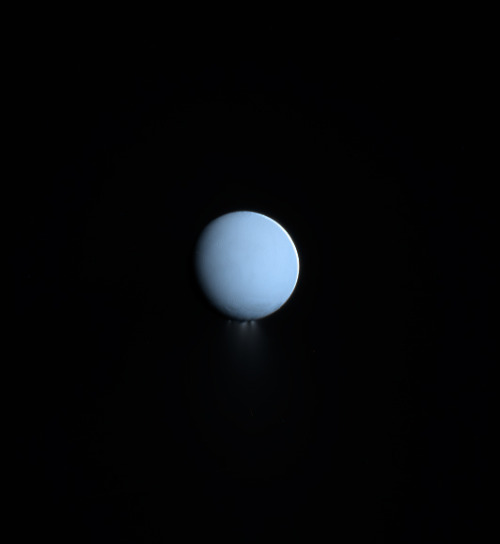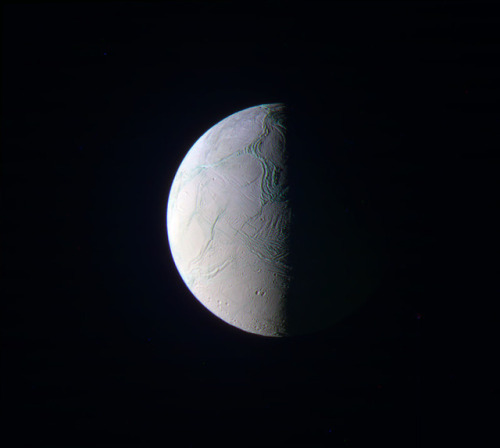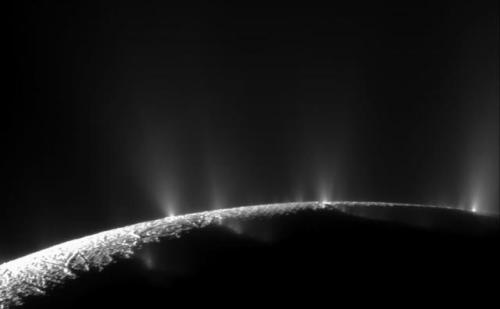Enceladus









Enceladus
Enceladus is one of the major inner moons of Saturn along with Dione, Tethys, and Mimas. It orbits Saturn at a distance of 148,000 miles (238,000 km), falling between the orbits of Mimas and Tethys. It is tidally locked with Saturn, keeping the same face toward the planet. It completes one orbit every 32.9 hours within the densest part of Saturn’s E Ring, the outermost of its major rings, and is its main source.
Enceladus is, like many moons in the extensive systems of the giant planets, trapped in an orbital resonance. Its resonance with Dione excites its orbital eccentricity, which is damped by tidal forces, tidally heating its interior, and possibly driving the geological activity.
Enceladus is Saturn’s sixth largest moon, only 157 miles (252 km) in mean radius, but it’s one of the most scientifically compelling bodies in our solar system. Hydrothermal vents spew water vapor and ice particles from an underground ocean beneath the icy crust of Enceladus. This plume of material includes organic compounds, volatile gases, carbon dioxide, carbon monoxide, salts and silica.
With its global ocean, unique chemistry and internal heat, Enceladus has become a promising lead in our search for worlds where life could exist.

In 2005, Cassini’s multiple instruments discovered that this icy outpost is gushing water vapor geysers out to a distance of three times the radius of Enceladus. The icy water particles are roughly one ten-thousandth of an inch, or about the width of a human hair. The particles and gas escape the surface at jet speed at approximately 800 miles per hour (400 meters per second). The eruptions appear to be continuous, refreshing the surface and generating an enormous halo of fine ice dust around Enceladus, which supplies material to one of Saturn’s rings, the E-ring.
Several gases, including water vapor, carbon dioxide, methane, perhaps a little ammonia and either carbon monoxide or nitrogen gas make up the gaseous envelope of the plume.
Read more at: solarsystem.nasa.gov
Image credit: NASA/JPL/Cassini & Kevin Gill
More Posts from Sharkspaceengine and Others




Triangulum Log - Post 4 - The Vista System (First Planet)
Top image shows the Andromeda Galaxy rising above the inner-most dwarf planet. From here, the great spiral galaxy covers over 11 degrees of the sky or almost 22 times larger than a full moon on Earth.
Other three images show the inner-most planet, a large ice giant 50 times the mass of Earth orbiting 0.30 AU from the sun.
In the last shot, each of the small stars in the background are actually large bright asteroids in the systems asteroid belt.
High Resolution Links Below
Image 1
Image 2
Image 3
Image 4
Ultra-Close Orbits of Saturn = Ultra-Cool Science
On Sept. 15, 2017, our Cassini spacecraft ended its epic exploration of Saturn with a planned dive into the planet’s atmosphere–sending back new science to the very last second. The spacecraft is gone, but the science continues!

New research emerging from the final orbits represents a huge leap forward in our understanding of the Saturn system – especially the mysterious, never-before-explored region between the planet and its rings. Some preconceived ideas are turning out to be wrong while new questions are being raised. How did they form? What holds them in place? What are they made of?

Six teams of researchers are publishing their work Oct. 5 in the journal Science, based on findings from Cassini’s Grand Finale. That’s when, as the spacecraft was running out of fuel, the mission team steered Cassini spectacularly close to Saturn in 22 orbits before deliberately vaporizing it in a final plunge into the atmosphere in September 2017.

Knowing Cassini’s days were numbered, its mission team went for gold. The spacecraft flew where it was never designed to fly. For the first time, it probed Saturn’s magnetized environment, flew through icy, rocky ring particles and sniffed the atmosphere in the 1,200-mile-wide (2,000-kilometer-wide) gap between the rings and the cloud tops. Not only did the engineering push the spacecraft to its limits, the new findings illustrate how powerful and agile the instruments were.
Many more Grand Finale science results are to come, but today’s highlights include:
Complex organic compounds embedded in water nanograins rain down from Saturn’s rings into its upper atmosphere. Scientists saw water and silicates, but they were surprised to see also methane, ammonia, carbon monoxide, nitrogen and carbon dioxide. The composition of organics is different from that found on moon Enceladus – and also different from those on moon Titan, meaning there are at least three distinct reservoirs of organic molecules in the Saturn system.

For the first time, Cassini saw up close how rings interact with the planet and observed inner-ring particles and gases falling directly into the atmosphere. Some particles take on electric charges and spiral along magnetic-field lines, falling into Saturn at higher latitudes – a phenomenon known as “ring rain.” But scientists were surprised to see that others are dragged quickly into Saturn at the equator. And it’s all falling out of the rings faster than scientists thought – as much as 10,000 kg of material per second.

Scientists were surprised to see what the material looks like in the gap between the rings and Saturn’s atmosphere. They knew that the particles throughout the rings ranged from large to small. They thought material in the gap would look the same. But the sampling showed mostly tiny, nanograin- and micron-sized particles, like smoke, telling us that some yet-unknown process is grinding up particles. What could it be? Future research into the final bits of data sent by Cassini may hold the answer.

Saturn and its rings are even more interconnected than scientists thought. Cassini revealed a previously unknown electric current system that connects the rings to the top of Saturn’s atmosphere.

Scientists discovered a new radiation belt around Saturn, close to the planet and composed of energetic particles. They found that while the belt actually intersects with the innermost ring, the ring is so tenuous that it doesn’t block the belt from forming.

Unlike every other planet with a magnetic field in our Solar System, Saturn’s magnetic field is almost completely aligned with its spin axis. Think of the planet and the magnetic field as completely separate things that are both spinning. Both have the same center point, but they each have their own axis about which they spin. But for Saturn the two axes are essentially the same – no other planet does that, and we did not think it was even possible for this to happen. This new data shows a magnetic-field tilt of less than 0.0095 degrees. (Earth’s magnetic field is tilted 11 degrees from its spin axis.) According to everything scientists know about how planetary magnetic fields are generated, Saturn should not have one. It’s a mystery physicists will be working to solve.

Cassini flew above Saturn’s magnetic poles, directly sampling regions where radio emissions are generated. The findings more than doubled the number of reported crossings of radio sources from the planet, one of the few non-terrestrial locations where scientists have been able to study a mechanism believed to operate throughout the universe. How are these signals generated? That’s still a mystery researchers are looking to uncover.
For the Cassini mission, the science rolling out from Grand Finale orbits confirms that the calculated risk of diving into the gap – skimming the upper atmosphere and skirting the edge of the inner rings – was worthwhile.

Almost everything going on in that region turned out to be a surprise, which was the importance of going there, to explore a place we’d never been before. And the expedition really paid off!
Analysis of Cassini data from the spacecraft’s instruments will be ongoing for years to come, helping to paint a clearer picture of Saturn.
To read the papers published in Science, visit: URL to papers
To learn more about the ground-breaking Cassini mission and its 13 years at Saturn, visit: https://www.nasa.gov/mission_pages/cassini/main/index.html
Make sure to follow us on Tumblr for your regular dose of space: http://nasa.tumblr.com.







Pictures of the day - December 27, 2018
Parting Shots of the Insight A and Insight B Systems, Alien Skies.
Now that all of the worlds of the Insight A and Insight B systems have been revealed, here are some parting shots before I begin my exploration of new star systems.
Space Engine System ID: RS 5581-42-6-76887-1116
High Resolution Pictures
Insight B-IV-M3 sky
Insight A-VII Sky
Insight A-V Sky
Insight A-IV-M8 Sky
Insight B-V Sky
Insight B-VI-M2 Sky
Insight B-I Sky
Insight A System (Outer 4 Planets)
Here are the outer 4 planets orbiting Insight A. Each planet has a large ring systems.
Insight A-VI (0.65 Earth masses, Water World with life, 1.10 AU)

Insight A-VII (3.10 Earth masses, Cold Desert World, 1.97 AU)

Insight A-VIII (15.46 Earth Masses, Ice Giant, 4.01 AU)

Insight A-IX (17.40 Earth Masses, Ice Giant, 7.34 AU)

Space Engine System ID: RS-5581-42-6-76887-1116 A
Space Engine on Pillowfort Coming Soon
Just to let all of my followers know. I have received by Pillowfort login and will be playing around with setting up a Space Engine blog on there.
http://www.pillowfort.io
I will still be keeping this blog as my primary blog, and my secondary blog rabbits and shark will also be staying here.
For the time being, I am just trying Pillowfort out, with the anticipation that Tumblr may eventually go under, but until then, I am staying on here, so please don’t worry about me leaving.
My Pillowfort link is below:
Sharkspaceengine
For anyone who doesn't know what Pillowfort is, it is beta blogging site that is possibly going to be an alternative to Tumblr. The site is currently still in beta and charges $5 for a key, but that is temporary, and once the main site is up and running there will be no charge.
New Blog is Up (Rabbits and Sharks)
My second blog, rabbits and shark’s is up and running. Pictures of my two buns are on there. The blog is all about just rabbits and sharks.
I’ll be continuing to update this blog regularly.
https://sharkrabbitandshark.tumblr.com/

The northern pole of a large moon orbiting the blue gas giant. The clouds like structures visible are two galaxies in the process of colliding.
-
 glittertrail reblogged this · 11 months ago
glittertrail reblogged this · 11 months ago -
 junosjukebox reblogged this · 11 months ago
junosjukebox reblogged this · 11 months ago -
 baddestvenus-in-virgo liked this · 1 year ago
baddestvenus-in-virgo liked this · 1 year ago -
 babars-orbit reblogged this · 1 year ago
babars-orbit reblogged this · 1 year ago -
 eisbar777 reblogged this · 1 year ago
eisbar777 reblogged this · 1 year ago -
 eisbar777 reblogged this · 1 year ago
eisbar777 reblogged this · 1 year ago -
 eisbar777 liked this · 1 year ago
eisbar777 liked this · 1 year ago -
 differentcheesecakeexpert liked this · 1 year ago
differentcheesecakeexpert liked this · 1 year ago -
 experiencecase liked this · 1 year ago
experiencecase liked this · 1 year ago -
 cohesin liked this · 1 year ago
cohesin liked this · 1 year ago -
 brandon1997 liked this · 2 years ago
brandon1997 liked this · 2 years ago -
 ielosp liked this · 2 years ago
ielosp liked this · 2 years ago -
 hloneheart reblogged this · 4 years ago
hloneheart reblogged this · 4 years ago -
 6enceladus liked this · 4 years ago
6enceladus liked this · 4 years ago -
 twisted24degrees liked this · 4 years ago
twisted24degrees liked this · 4 years ago -
 utoplla liked this · 4 years ago
utoplla liked this · 4 years ago -
 hana-no-ami reblogged this · 4 years ago
hana-no-ami reblogged this · 4 years ago -
 hana-no-ami liked this · 4 years ago
hana-no-ami liked this · 4 years ago -
 exploring2000 liked this · 4 years ago
exploring2000 liked this · 4 years ago -
 skiitter reblogged this · 4 years ago
skiitter reblogged this · 4 years ago -
 thomasbrisenio reblogged this · 4 years ago
thomasbrisenio reblogged this · 4 years ago -
 alerintelmari liked this · 4 years ago
alerintelmari liked this · 4 years ago -
 ampleappleamble liked this · 4 years ago
ampleappleamble liked this · 4 years ago -
 fangmich reblogged this · 4 years ago
fangmich reblogged this · 4 years ago -
 heygamez reblogged this · 4 years ago
heygamez reblogged this · 4 years ago -
 thomasbrisenio liked this · 5 years ago
thomasbrisenio liked this · 5 years ago -
 captainsophieblog liked this · 5 years ago
captainsophieblog liked this · 5 years ago -
 karategomez liked this · 5 years ago
karategomez liked this · 5 years ago -
 tworocks liked this · 5 years ago
tworocks liked this · 5 years ago -
 universallyhiphoplovelight liked this · 5 years ago
universallyhiphoplovelight liked this · 5 years ago -
 rossemus liked this · 5 years ago
rossemus liked this · 5 years ago -
 rggsoccer1 liked this · 5 years ago
rggsoccer1 liked this · 5 years ago -
 thomasbrisenio reblogged this · 5 years ago
thomasbrisenio reblogged this · 5 years ago -
 94pigeons reblogged this · 5 years ago
94pigeons reblogged this · 5 years ago -
 94pigeons liked this · 5 years ago
94pigeons liked this · 5 years ago -
 niedzwiedz-bipolarny liked this · 5 years ago
niedzwiedz-bipolarny liked this · 5 years ago -
 galexion liked this · 5 years ago
galexion liked this · 5 years ago -
 wolfwarrior142 reblogged this · 5 years ago
wolfwarrior142 reblogged this · 5 years ago -
 wolfwarrior142 liked this · 5 years ago
wolfwarrior142 liked this · 5 years ago -
 allrainsfromabove reblogged this · 5 years ago
allrainsfromabove reblogged this · 5 years ago -
 allrainsfromabove liked this · 5 years ago
allrainsfromabove liked this · 5 years ago -
 toto19-the-exo-hunter reblogged this · 5 years ago
toto19-the-exo-hunter reblogged this · 5 years ago
My Space Engine Adventures, also any space related topic or news. www.spaceengine.org to download space engine. The game is free by the way. Please feel free to ask me anything, provide suggestions on systems to visit or post any space related topic.Check out my other blog https://bunsandsharks.tumblr.com for rabbit and shark blog.
294 posts






